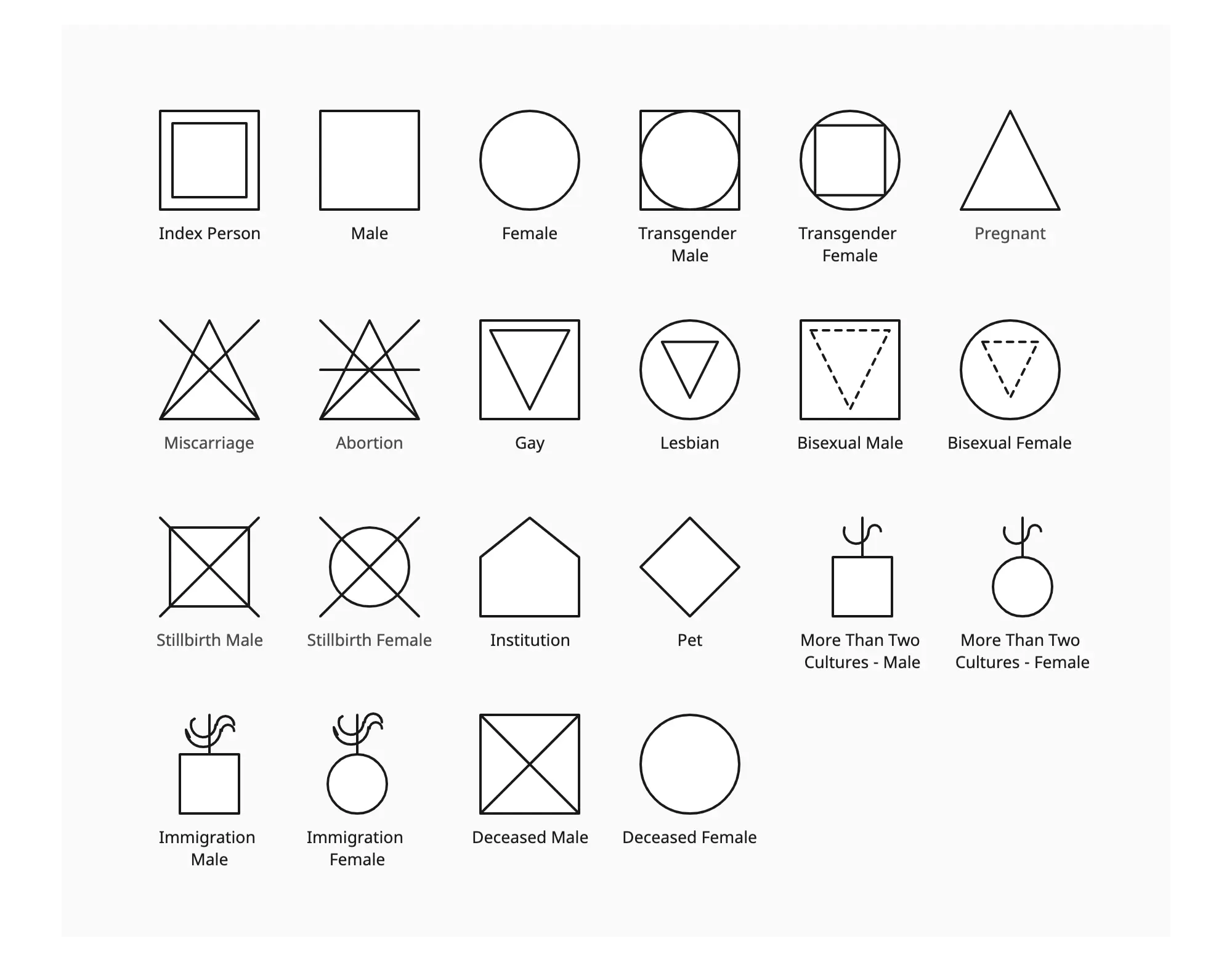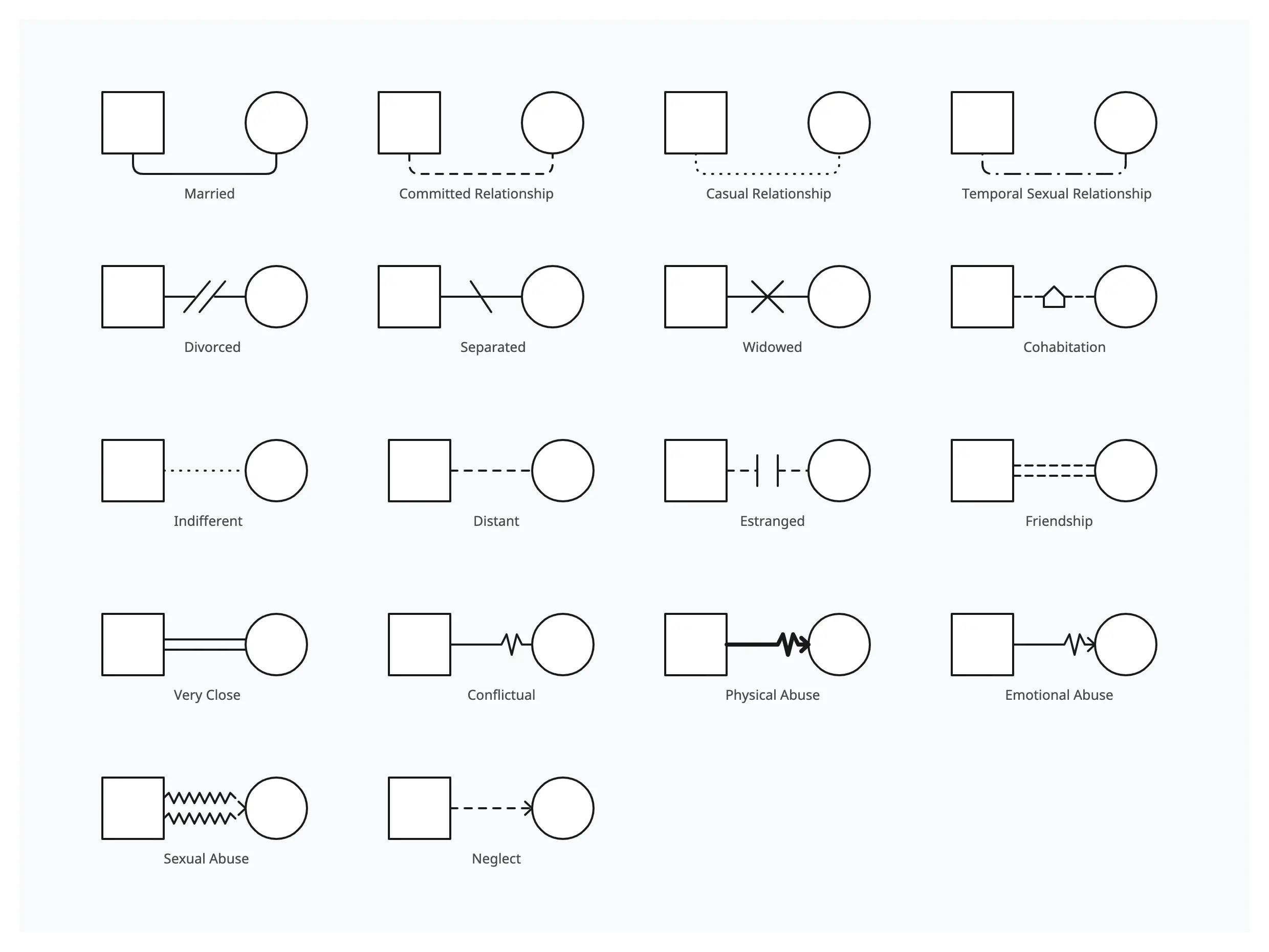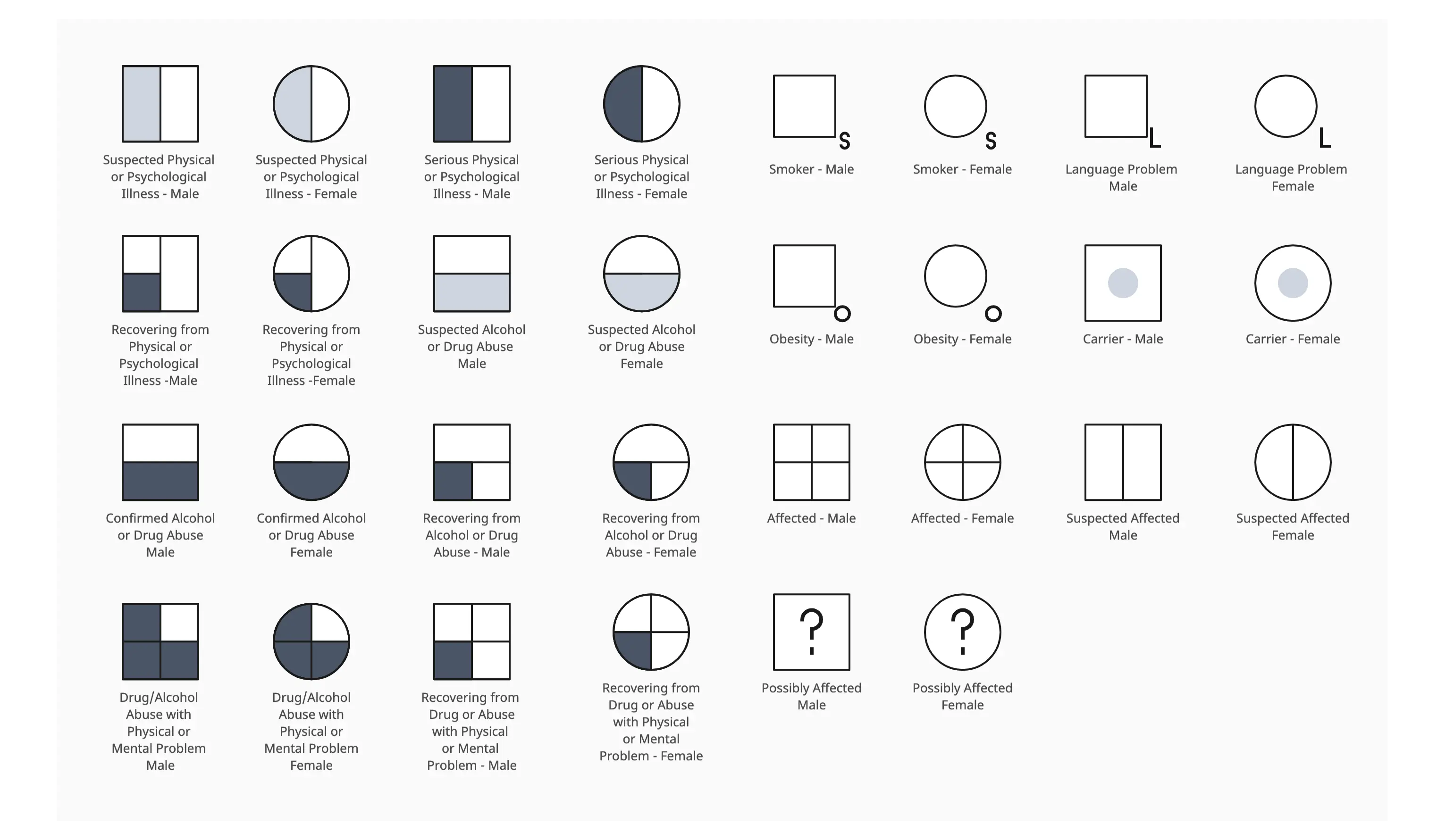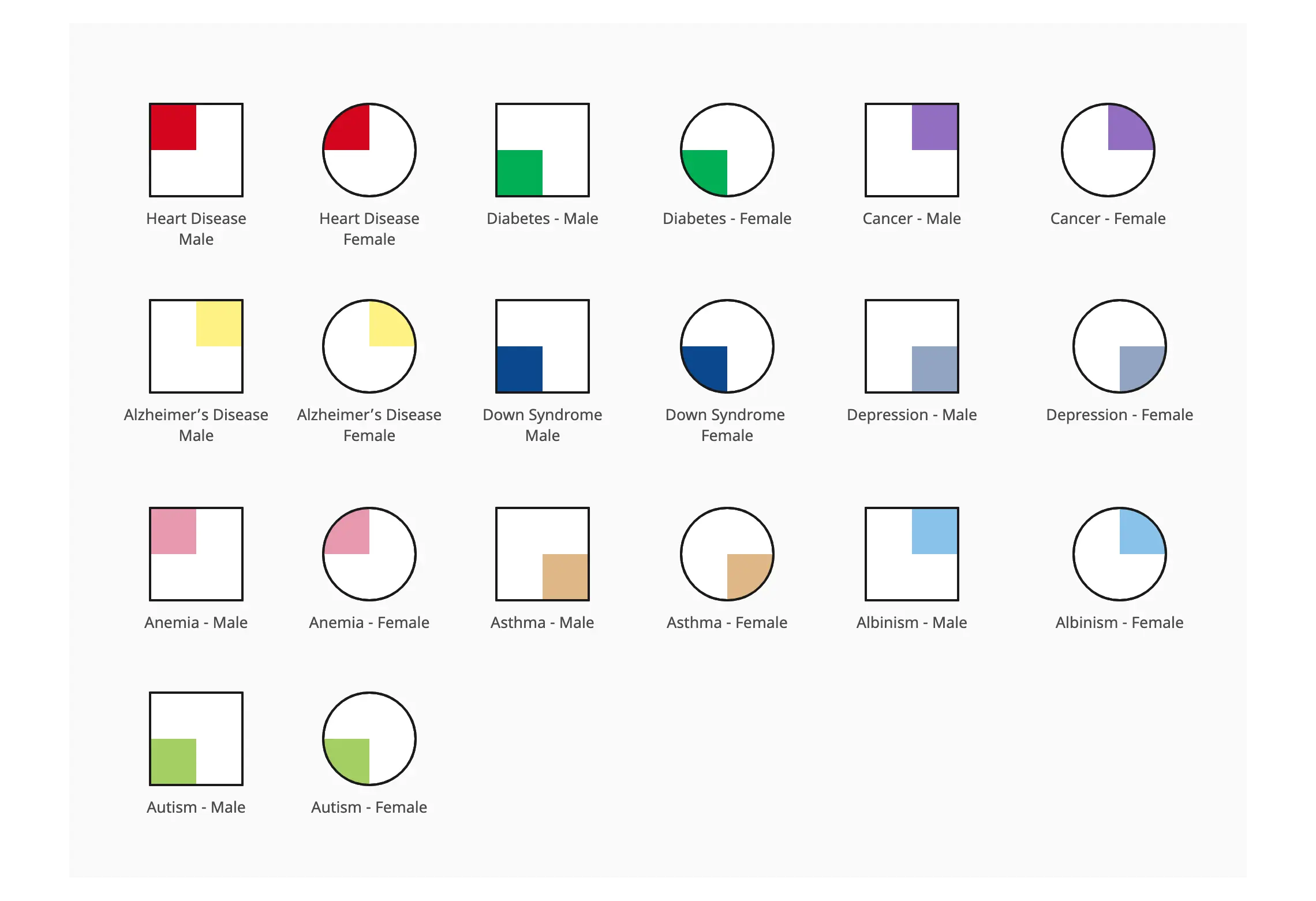Learn how to make a genogram with ease using symbols, templates, and examples. This quick guide covers steps, tools, and best practices for building accurate family genograms.
How to Make a Genogram in 7 Minutes
Making a genogram is a relatively straightforward process. Here are the basic steps on how to make a genogram:
- Gather names, birthdates, and key family details.
- Choose symbols for gender and relationships.
- Arrange family members hierarchically, starting with yourself.
- Add details like marriages and divorces with varied lines.
- Label each member with names and essential info.
- Use line styles to show relationship types.
- Analyze for patterns and insights.
Our genogram maker simplifies this process by providing you with the following,
- Comprehensive genogram shape library
- Easy way to show multiple relationship types
- Professional designed genogram templates
- Ability to add files, medical records as shapes
- Powerful customization to show index person
Step 1. Gather information
Start by collecting detailed information about each family member. This includes names, birthdates, and key life events, but aim to go further by exploring information that reveals patterns, such as:
- Education and career paths
- Health conditions or major illnesses
- Significant life events, challenges, or achievements
Speaking to multiple relatives can help you gather different perspectives and fill in any gaps, creating a fuller picture of your family’s history.
Step 2. Choose symbols
Genograms are most effective when genogram symbols are used consistently and with intent. Standard genogram symbols are designed to quickly represent complex family relationships and patterns, so it’s worth taking time to learn them. If your family has unique dynamics, such as recurring health issues or shared generational hobbies, you can also create custom symbols to reflect those.
Step 3. Draw the genogram
Begin with yourself at the center or base of the genogram, connecting yourself to your parents, siblings, and then extended family. Arrange each generation hierarchically, with older generations at the top and younger generations below. To maintain clarity:
- Work systematically from one side of the family to the other.
- Draw from oldest to youngest within each generation for an organized flow, making it easier to spot patterns.
Step 4. Include additional details
This step is where the genogram can go beyond a simple family tree and become a rich resource for understanding family dynamics. Use different lines or markers to indicate marriages, divorces, estranged relationships, adoptions, and other important connections. By differentiating between relationship types, you can highlight key dynamics and see patterns or recurring issues (like separations or tight family bonds) that have affected multiple generations.
Step 5. Add labels
Each family member should be labeled not just with their name but also with any relevant identifiers that make their role or history clear at a glance. Consider labeling with details that stand out or may have impacted family dynamics, such as educational achievements, major relocations, or significant life changes. Including full names and both birth and death dates (if applicable) helps anchor each individual’s place in the family history.
Step 6. Indicate connections
Represent relationships with a variety of line styles and thicknesses to convey the type and strength of each connection. Solid lines can represent strong or close connections, while dashed or thinner lines could indicate less frequent or strained interactions. If emotional or behavioral patterns are central to your genogram’s purpose, use distinct line styles to represent types of relationships (e.g., supportive, conflicted, distant), giving added depth to the visual.
Step 7. Interpret and analyze
This step involves closely studying the genogram to identify themes, behavioral patterns, and any recurring influences that emerge across generations. Look for intergenerational patterns, like career paths, family health trends, or recurring interpersonal dynamics (such as strong bonds between certain family members or frequent relocations). Taking time to analyze these patterns can help you understand how family histories shape current relationships and experiences.
Why Create a Genogram?
A genogram shows your family members and helps you understand important patterns like health issues, emotions, and relationships that affect your family.
Here are some key reasons to create a genogram:
1. To understand family patterns
Genograms help you see repeating behaviors, roles, or dynamics across generations—like cycles of conflict, divorce, or support. This insight is especially useful in therapy or personal reflection.
2. To explore emotional relationships
Unlike a regular family tree, genograms show emotional bonds between people. You can see who is close, distant, or in conflict—helping you understand your emotional environment better.
3. To track medical history
Genograms are often used in healthcare to map out genetic risks and recurring health conditions. They give doctors a clear picture of hereditary issues like heart disease, cancer, or mental health disorders.
4. To support therapy and counseling
Therapists use genograms to explore how a client’s family history affects their current relationships and challenges. It’s a helpful visual tool for starting meaningful conversations.
5. To guide decisions in social work
Social workers use genograms to assess family systems, identify risks, and create better support plans for individuals and families in need.
6. To reflect on your own story
You don’t have to be a professional to use a genogram. Many people create one simply to learn more about where they come from and how their upbringing may have shaped who they are today.
When to Create a Genogram
A genogram is more than a family tree. It’s a helpful visual tool that shows family patterns, relationships, and health history. Here’s when it can be most useful:
1. When you want a deeper understanding of family dynamics
Use a genogram when you want to explore emotional bonds, roles, and recurring behaviors in your family. It helps reveal how the past affects the present.
2. In therapy and counseling sessions
Therapists often use genograms to uncover hidden patterns, relationship issues, or emotional struggles passed down through generations.
3. When tracking medical history
They’re valuable for spotting inherited health conditions like heart disease, diabetes, or mental health concerns—useful for better prevention and care.
4. During major life transitions
Big family shifts like divorce, loss, or remarriage are easier to understand with a genogram. It shows new roles and helps people adjust.
5. For estate planning and legal purposes
In legal matters, a genogram helps organize family relationships clearly—useful in inheritance planning and avoiding confusion or disputes.
6. In social work and case management
Social workers use genograms to see family support systems and spot areas needing help. It gives a quick, clear view of relationships and risks.
7. In educational settings
Educators or school counselors can use genograms to understand a student’s home life and better support their learning and well-being.
Genogram Symbols
Genogram symbols may vary based on professional or cultural conventions. When creating or interpreting a genogram, always use key symbols consistently and explain them clearly for accurate understanding and communication. Here are some common genogram symbols and their meanings:
Basic Genogram Symbols 
Family Relationships 
Medical Genogram Symbols 
Medical Genogram Symbols - Colored 
Tips and Best Practices for Creating Genograms
1. Gather accurate information
Make sure that you have accurate and up-to-date information about family members. Double-check names, dates of birth, and other relevant details to ensure the genogram is as accurate as possible.
2. Maintain confidentiality
Genograms contain personal and sensitive information about individuals and their families. It is crucial to maintain confidentiality and use genograms only in appropriate professional settings, adhering to ethical guidelines and privacy regulations.
3. Create a safe and supportive environment
When discussing genograms with clients or patients, create a safe and supportive environment for them to share their family history and experiences. Encourage open communication and active listening to create a deeper understanding.
4. Consider cultural sensitivity
Be aware of cultural considerations and sensitivities when creating and interpreting genograms. Different cultures may have unique symbols, values, or expectations related to family dynamics. Respect and honor diverse perspectives and practices.
5. Encourage collaboration
Involve clients or patients in the process of creating genograms. Encourage them to share their insights, interpretations, and perspectives about their family relationships and patterns. This collaboration helps build a sense of ownership and empowerment.
6. Use genograms as a starting point
Genograms provide a snapshot of family dynamics, but they are not the entire story. Use them as a starting point for exploration and understanding. Combine genogram information with other assessment tools, therapeutic techniques, and interventions to develop a comprehensive understanding of the individual and their family system.
7. Maintain neatness and organization
Create a clean and organized genogram by using straight lines, spacing symbols appropriately, and labeling family members clearly. This enhances readability and makes it easier to interpret the genogram.
Common Mistakes to Avoid When Making Genograms
Creating a genogram can be insightful, but avoiding common mistakes is essential to ensure accurate interpretation and meaningful results. Here are a few things to watch out for:
1. Not setting a clear purpose
Before you start, ask yourself why you’re making the genogram. Is it to explore family history, track medical conditions, or understand emotional patterns? Having a clear purpose helps you focus on the right information and keep the genogram meaningful.
2. Using inconsistent symbols
Genograms rely on specific shapes and lines to show relationships. If you switch symbols or make them up as you go, it can be hard to read or understand later. Stick to standard genogram symbols and keep things consistent throughout.
3. Leaving out important details
When learning how to make a genogram, it’s easy to focus just on names and dates. But emotional ties, patterns of conflict, health issues, and life events matter too. Try to include these kinds of information when they are relevant and available.
4. Making it too complicated
A genogram should be detailed, but not overwhelming. Adding too much at once can make it hard to follow. Focus on key relationships and information that supports your goal, and expand only as needed.
5. Not checking for accuracy
It’s easy for small mistakes to slip in—like missing a sibling or confusing dates. Take time to double-check the information you’ve gathered with family members or other reliable sources.
6. Ignoring non-biological relationships
Families come in many forms. When figuring out how to make a genogram, don’t forget to include step-relatives, adoptive family members, or close non-family figures if they play a meaningful role in someone’s life.
7. Forgetting to update the genogram
Families change—new relationships form, people pass away, children are born. A genogram is most useful when it’s kept up to date. Try to revisit and revise it when needed, especially for long-term use.
Genogram Examples and Templates
Family Genogram Template
Career Genogram
3 Generations Genogram Template
Cultural Genogram
Genogram Template for Relationship Types
Here’s a quick tutorial on how to use Creately’s free genogram maker to create a genogram.
References
Joseph, B., Dickenson, S., McCall, A. and Roga, E. (2022). Exploring the Therapeutic Effectiveness of Genograms in Family Therapy: A Literature Review. The Family Journal, 31(1), pp.21–30. doi:https://doi.org/10.1177/10664807221104133.
www.sciencedirect.com. (n.d.). Genogram - an overview | ScienceDirect Topics. [online] Available at: https://www.sciencedirect.com/topics/medicine-and-dentistry/genogram.






